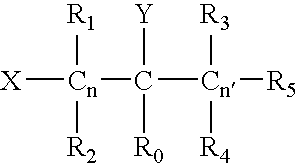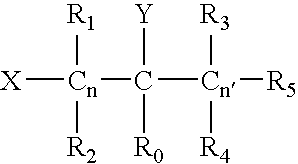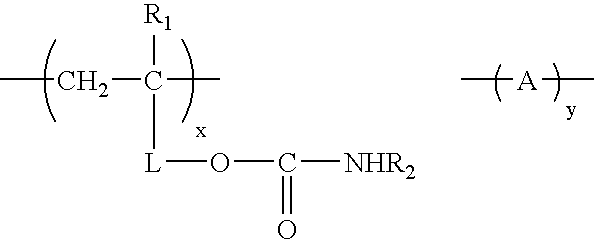Curable coating compositions with carbamate compounds
a technology of carbamate compounds and coating compositions, which is applied in the direction of polyurea/polyurethane coatings, metal layered products, synthetic resin layered products, etc., can solve the problems of difficult to predict the degree of resistance to environmental etch, high-gloss and composite color-plus-clear coatings are susceptible to environmental etching phenomenon, and do not provide the desired level of environmental etching resistance when used in high gloss coatings and color-plus-clear
- Summary
- Abstract
- Description
- Claims
- Application Information
AI Technical Summary
Benefits of technology
Problems solved by technology
Method used
Image
Examples
example 1
Preparation of the Reactive Compound (C) by the Method of the Invention
[0124]A mixture of 55.69 parts of 2-ethyl-1,3-hexanediol, 20.94 parts of methyl carbamate, 23.26 parts of toluene and 0.07 parts of dibutyl tin oxide were heated under an inert atmosphere to reflux in a reactor equipped with an extractor that can remove methanol but returns toluene to the reaction mixture. Once at reflux, the inert atmosphere was turned off. An additional 0.04 parts of dibutyl tin oxide was added after the first three hours at reflux. Additional toluene was added to the reaction mixture to keep the reflux temperature below 130° C. The reaction was stopped when ˜85% of the theoretical amount of hydroxy groups were converted into carbamate groups. Free methyl carbamate, toluene and some of the unconverted 2-ethyl-1,3-hexanediol was then removed by vacuum distillation. The final product was a mixture of 55.5% 2-ethyl-1,3-hexanediol, 42.3% 3-hydroxy-2-ethyl carbamate and 2.2% 2-ethylhexane1,3-dicarba...
example 2
Preparation of the Reactive Compound (C) by the Method of the Invention
[0125]A mixture of 45.52 parts of 2-ethyl-1,3-hexanediol, 23.4 parts of methyl carbamate, 0.08 parts butyltin hydroxide oxide and 30.4 parts toluene was headed heated under an inert atmosphere to reflux in a reactor equipped with an extractor that can remove methanol but return toluene to the reaction mixture. Once at reflux, the inert atmosphere was turned off. The reaction was stopped when approximately half of the theoretical amount of mono-carbamate product was formed. Then 0.6 parts of octanethiol was added and the reaction mixture was held at 100° C. for 1.5 hours. Free methyl carbamate, toluene, octanethiol and some of the unconverted 2-ethyl-1,3-hexanediol was then removed by vacuum distillation. The final product was a mixture of 43.0% 2-ethyl-1,3-hexanediol and 53.2% 3-hydroxy-2-ethylhexane carbamate and 3.7% 2-ethyl-1,3-hexane dicarbamate.
example 3
Prophetic Preparation of a Curable Coating Composition of the Invention
[0126]The following materials would be added in order to a stainless steel one-quart container and subsequently placed under medium agitation (a mixing blade) for approximately fifteen to twenty minutes. The resulting clear coating composition would have a theoretical % NV of 57.0%.
[0127]
Raw material componentAmount (grams)Reactive compound (C) from Ex. 1335.70Carbamate functional resin1116.00Curing agent (B)2141.87Catalyst310.55UVA10.55HALS2.11Flow additive42.93Rheology control agent536.62n-butyl acetate93.62n-butanol17.58150% NV Carbamate functional resin per the examples of U.S. Pat. No. 5,512,639 2Fully methylated monomeric aminoplast 325% blocked DDBSA in methanol 4polysiloxane flow additive 59.6% fumed silica ground in a 65% NV carbamate functional acrylic resin per U.S. Pat. No. 6,423,788
PUM
| Property | Measurement | Unit |
|---|---|---|
| cure temperatures | aaaaa | aaaaa |
| cure temperatures | aaaaa | aaaaa |
| temperatures | aaaaa | aaaaa |
Abstract
Description
Claims
Application Information
 Login to View More
Login to View More - R&D
- Intellectual Property
- Life Sciences
- Materials
- Tech Scout
- Unparalleled Data Quality
- Higher Quality Content
- 60% Fewer Hallucinations
Browse by: Latest US Patents, China's latest patents, Technical Efficacy Thesaurus, Application Domain, Technology Topic, Popular Technical Reports.
© 2025 PatSnap. All rights reserved.Legal|Privacy policy|Modern Slavery Act Transparency Statement|Sitemap|About US| Contact US: help@patsnap.com



